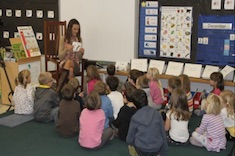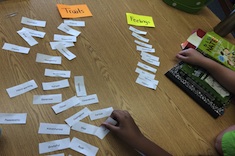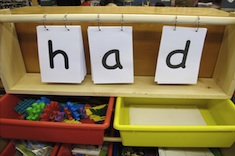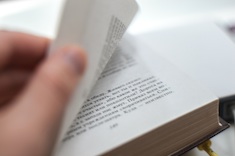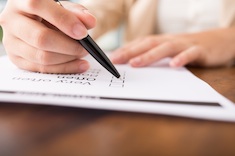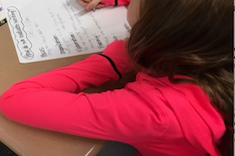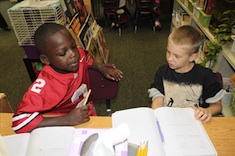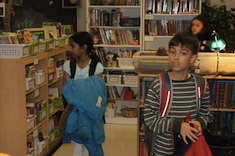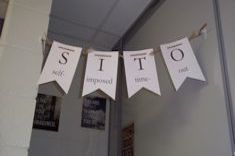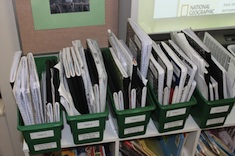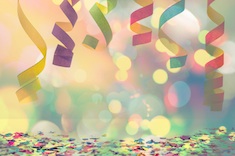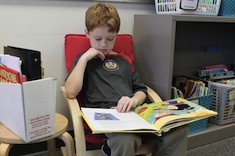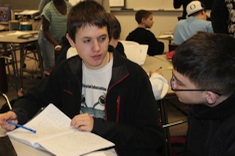Articles
Here is where you’ll find all the latest print features from our contributors. If you’d like to browse specifically by grade level, topic, or contributor, you can use the links in the right sidebar.
Latest Content
Temporary Strategies
Clare Landrigan confers with a student and discovers that a tool designed to help the reader is actually hindering her learning. The experience causes her to reflect on the need for flexibility when matching strategy scaffolds to young readers.
Supporting Talk Around Writer’s Craft
Tara Barnett and Kate Mills help young writers move away from seeing editing as “adding more details,” and toward developing more specific language for the revision process.
May’s Menu
Maria Caplin gives her students a range of options for closing out a year of literacy learning in style.
Strategies for Elaboration in Opinion Writing
Melanie Meehan works with fifth graders who are struggling to elaborate on themes in their opinion writing.
Weaving in Poetry
Gigi McAllister shares suggestions for infusing poetry throughout classrooms and the literacy curriculum all year long.
The Case for the Sonnet
Gretchen Schroeder makes a case for teaching the sonnet to teenagers in the age of texts and Twitter.
Message from Old Crow
The end of winter is upon us! Shirl McPhillips celebrates with a poem about an old crow and reflections on revising poems over time.
Character Traits Through Word Sorts
Melanie Swider finds word sorts are a great way to help intermediate students master new vocabulary for describing character traits.
Building Word Learning Routines
Cathy Mere shares tried-and-true strategies for word learning with struggling young learners.
Vocabulary Instruction: Where to Start?
Gretchen Schroeder looks for new ways to help high school students learn words.
Holding a Dictionary
Jennifer Schwanke finds dictionaries (the real, not virtual, variety) are still a potent tool for teaching new vocabulary to children.
Learning Vocabulary in Context with English Language Learners
Stella Villalba explores why it is so important to teach vocabulary to English language learners in context.
Tests of Time
This vivid new poem from Shirley McPhillips, explores the disconnect between exams and life.
Observations and Test Preparation
Christopher Carlson takes on the role of observer and researcher to analyze his students' needs when it comes to test-taking skills, and enlists students in the process of reflecting on his data to implement new test-taking strategies.
Student Self-Assessment Strategies
Melanie Meehan works with fifth graders to help them create their own set of indicators of success in a writing unit.
Read Alouds and Standards
Maria Caplin explains how read alouds do double duty in her fifth-grade classroom, as they help build a love for story and help students master key literacy and content area standards.
Setting the Stage for Meaningful Peer Feedback
Tara Barnett and Kate Mills develop a scaffold with an index card to help student partners move from agreeable talk to suggestions for revising writing.
What’s a Great Workshop Day?
Mary Lee Hahn considers how the success of any day has to integrate observations from conferring, lessons, and share sessions.
Shared Reading in the Digital Age
Shari Frost finds that shared reading routines are easier to implement now because of tech tools.
SITO: Self-Imposed Time-Out
Christy Rush-Levine takes an oddly shaped unused nook in her classroom and turns it into a charming space where students can choose to take a quiet break with a “Self-Imposed Time-Out” (SITO).
Slow Down
Gretchen Schroeder has three strategies for slowing down with her high school students and savoring literacy learning.
Planning and the Tuesday Effect
Mary Lee Hahn realizes how much a workshop approach has changed her planning process and comfort level with the unexpected.
Getting Creative with Writing Celebrations
A celebration is the pause that refreshes between writing units for many teachers. Melanie Meehan shares suggestions for creative celebrations.
The Compliment Conference
Katrina Edwards confers with Camilla, a struggling reader. She is a child who has no confidence in herself. The Compliment Conference is a way to acknowledge and build upon Camilla’s strengths, and boost her self-esteem at the same time.
Wonder and React
How do you scaffold students for independent work? Melanie Meehan finds Wonder and React is a great strategy to use with fifth graders during an information writing unit.
Growing Toward Independence
Cathy Mere shares what to look for and what to try next with young learners who are easily distracted and struggling to concentrate during independent reading.
Time for What Matters
Gretchen Schroeder has only 42 minutes with her high school students each day. She explains how she establishes priorities.
Building Stamina in Middle School Writers
Carly Ullmer finds herself wasting a lot of time because of interruptions during student conferences, so she makes building stamina in her middle school students a priority.
Extended Inquiry with Article of the Week
Gretchen Schroeder finds the article of the week activity is an excellent vehicle for learning about content literacy gaps in student background knowledge and how to fill them.
“Giving Ourselves Hard Problems”: Rethinking Math Workshop
Mary Lee Hahn rethinks her math workshop structure to more closely align with the choice and problem solving in her reading and writing workshops.
Browse Content By
Type
Category
- Assessment Tools
- Big Fresh Archives
- Booklists
- Choice Numeracy
- Classroom Design
- Common Core
- Community Building
- Conferring
- Content Literacy
- Digital Literacy
- English Language Learners
- Equity
- Family Relations
- Free Samples
- Guiding Groups
- Leadership
- Literacy Coaches
- Mentor Texts
- Minilessons
- New Teacher Mentors
- Podcasts
- Poetry
- Quote Collections
- Reading Strategies
- Self Care
- Struggling and Striving Learners
- Talking and Listening
- Teacher Study Groups
- Teaching Reading
- Teaching Writing
- Word Study and Vocabulary
Author
- Melissa Quimby
- Nawal Qarooni
- Gwen Blumberg
- Julie Cox
- The Lead Learners
- Hannah Tills
- Josie Stewart
- Ruth Metcalfe
- Mallory Messenger
- Becca Burk
- Jodie Bailey
- Vivian Chen
- Mary Brower
- Tiffany Abbott Fuller
- Stephanie Affinito
- Ruth Ayres
- Leigh Anne Eck
- Heather Fisher
- Shari Frost
- Julie Johnson
- Suzy Kaback
- Gigi McAllister
- Shirl McPhillips
- Melanie Meehan
- Cathy Mere
- Debbie Miller
- Tara Barnett and Kate Mills
- Tammy Mulligan
- Dana Murphy
- Bitsy Parks
- David Pittman
- Brenda Power
- Heather Rader
- Matt Renwick
- Mandy Robek
- Christy Rush-Levine
- Gretchen Schroeder
- Jen Schwanke
- Brian Sepe
- Katherine Sokolowski
- Stella Villalba
- Jennifer Vincent
Grade Level
Choice Literacy Membership
Articles
Get full access to all Choice Literacy article content
Videos
Get full access to all Choice Literacy video content
Courses
Access Choice Literacy course curriculum and training





